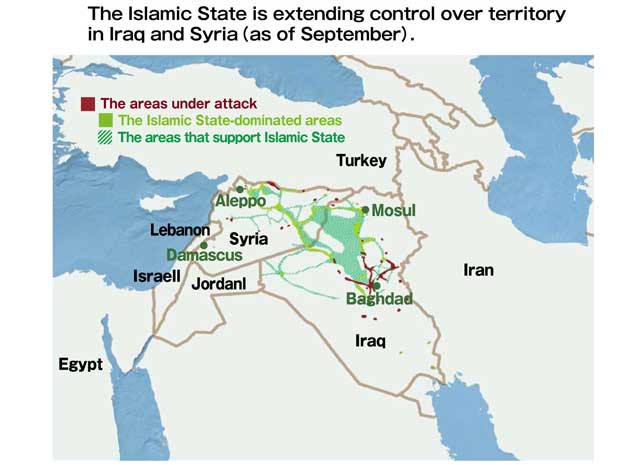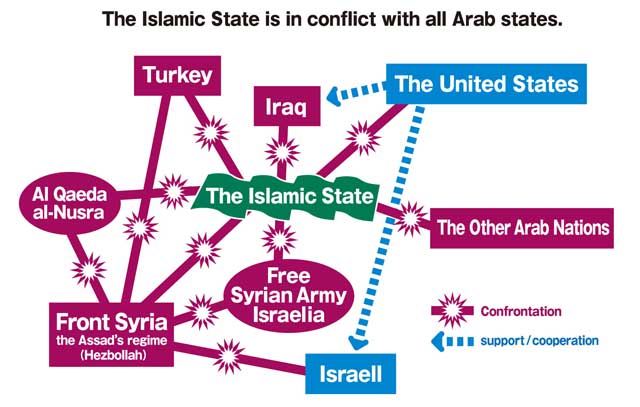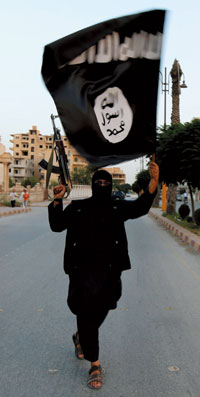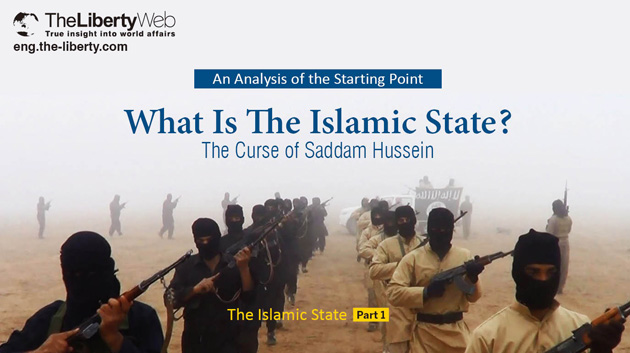What Is The Islamic State: The Curse of Saddam Hussein
The rise of the Islamic State, the Syrian Civil War, Israeli airstrikes in the Gaza Strip―why are there endless conflicts in the Middle East? In a two part series of articles, we will get to the core of the problems in the Middle East.
(Editors: Hiroko Otsuka, Hanako Cho, Tomohiro Tadaki, Kazutaka Nakahara, Harue Komoto)
The Current Conflicts in the Middle East That Are of Great Concern to the World Stem Mainly from Two Problems
The first one is the escalating violence by terrorist groups throughout the world. Since the 9/11 terrorist attack in the United States, terrorist groups have been wreaking havoc around the world. The international community has attempted all types of measures to allay the attacks, but none have prevented new terrorist groups like the Islamic State from springing forth. This problem is intertwined with the Islamic sectarian conflicts.
Another problem is the conflict over Palestine, between the Jewish state of Israel and the surrounding Muslim states in the Arab world. With the support of Christian nations in the West, Israel boasts world-class military capabilities including nuclear weapons. The volatile situation continues in the Gaza strip between Israeli and Hamas, the Palestinian Islamic organization.
What is the root cause behind the problems in the Middle East? In light of the spiritual truths revealed through a spiritual reading conducted at Happy Science, we will try to find solutions to these problems.
The Islamic State (IS) has seized large swaths of territory in eastern Syria and across northern and western Iraq. According to information provided by the Syrian Observatory for Human Rights (SOHR) as of the end of September, IS now have about 100,000 fighters.
Israeli airstrikes on the Gaza Strip
In June and August of this year, Israel carried out attacks on the Palestinian autonomous region of the Gaza strip, which killed more than 2,000 people including civilians.
Islamic State (IS)
The Islamic State has grown in power in Iraq and Syria. It proclaimed itself a caliphate, which led to confrontations with various forces in the Middle East.
Syrian Civil War
It began as nationwide protests against Bashar al-Assad’s government and developed into civil war. More than 190,000 people have been killed in the conflicts.
There are endless conflicts in the Middle East.
Afghanistan ~ Iran ~ Kuwait ~ Iraq ~ Turkey ~ Syria ~ Lebanon ~ Jordan ~ Israel ~ Egypt ~ Saudi Arabia ~ Bahrain ~ Qatar ~ the United Arab Emirates ~ Oman ~ Yemen
What Is the Islamic StateRadical Islamist groups are one of the major causes of the Middle East conflicts. In particular, the Islamic States (IS) have grown significantly in Iraq and Syria, and this has created great concern worldwide. In an attempt to terrorize the world by releasing the video footage of the execution of an American journalist led the United States to conduct airstrikes on IS.. Is it really possible to put an end to the violent act of the Islamic extremists?
What Is The Islamic State?
The Islamic State identifies itself as a state, but no country in the world recognizes it as such. It is an Islamic extremist group just like the Taliban and Al Qaeda.
Unlike other groups, the Islamic State not only carries out acts of terrorism, but also has overrun large swath of territory in Iraq and Syria. It was originally called the “Islamic State of Iraq and Syria” (ISIS).
Now that U.S. forces have begun launching airstrikes against the militants, their territorial gains are expected to shrink. But what made them expand their power base so much in the first place?

Islamic State is extending control over territory in Iraq and Syria (as of September).
Islamic State Has Grown in Power by Taking Advantage of the Syrian Civil War and the US Withdrawal from Iraq
The Islamic State militant group was founded in 1999. During the Iraq War in the 2000s, it started its activities in Iraq, and pledged allegiance to the Osama Bin Laden-led Al Qaeda, and as its affiliate. It started to grow significantly around 2011, when the United States withdrew all military forces from Iraq, and the civil war in Syria became violent.
In Iraq, IS allied with the remnants of the Baath Party, which was once led by former President Saddam Hussein. The Shiite-led government that was formed after the U.S. occupation had excluded the members of the Sunni-majority Baath party. They wanted to return to power, so they decided to join forces with the Islamic State, another Sunni Islamic group.
Despite the fact that the number of civilian casualties rose to the tens of thousands in Syria, U.S. President Barack Obama did not intervene militarily in the conflict. The Islamic State began to gain strength amidst the intensifying conflict between Syrian government forces and rebel groups such as the Free Syrian Army. The power vacuum created by U.S. hesitation to intervene resulted in the advancement of IS growth in strength.
However, in August of this year, when the video footage of the execution of an American journalist James Foley was posted on U-Tube, American public opinion shifted completely, and led Obama to launch airstrikes on the Islamic State. He denounced the Islamic State as a “cancer” that must be eradicated from the Middle East. The U.S. is now carrying out airstrikes along with some European and Middle Eastern nations (as of October 19th).

Islamic State is in conflict with all Arab states.
The Earnest Desire of Islamic Fundamentalists Is to Re-establish a Caliphate

A fighter walking with a flag of Islamic State in Raqqa, a city in northern Syria (Reuters/Aflo)
What is the ultimate goal of Islamic State?
Like other Islamic extremist groups, they also adhere to the tenets of Islamic fundamentalism, which demands a strict adherence to orthodox theological doctrines dating back to the birth of Islam. They regard the rules and intervention by the West over the past century as the historical humiliation of Islam, and attribute this to the absence of a strong caliphate.
After the founder of Islam, Muhammad, died in the 7th century, his successors (caliphs) established the caliphates or Muslim empires, which lasted until the collapse of the Ottoman Empire. The caliphates once led the world in fields such as economy and science, and the Ottoman Empire, one of the caliphates, even destroyed the Eastern Roman Empire. Islamic fundamentalists believe that adhering to orthodox theological doctrines will allow them to restore the past glory of Muslim empires.
For this purpose, Abu Bakr al-Baghdadi, the leader of the Islamic State, declared the creation of a caliphate, and named himself the caliph. Not even attempting to hide its ambition for territorial expansion, IS has released a map that outlines territory it aspires to control in the next five years.
The Fundamental Difference in Interpretation about Jihad
This ideology of Islamic Fundamentalism is quite different from that of ordinary Muslims. In September, Ulamas (Muslim legal scholars) all over the world sent a letter to the Islamic State, in which they listed 24 items that pointed out the mistakes in IS’s thoughts and actions based on the tenets of Islam.
One of the items is about the concept of jihad. In the letter, the scholars state that if they interpret jihad in a modern way, according to the tenets of Islam, it means a war to defend faith.
On the contrary, the Islamic State explains on its website that jihad means killing non-Muslims and apostates of Islam in a war. This interpretation is shared by other Islamic extremist groups.
This fundamental difference in the interpretation of the tenets is one of the reasons extremists are emerging from Islam, which originally means “the devotion to God” or “peace.”
Why Are Young People from Western Countries Joining The Islamic State?

Despite its radical ideology, the Islamic State has successfully recruited a large number of young people from Western countries, which has become a serious international problem. According to The Soufan Group, an intelligence firm based in New York, over 12,000 fighters from at least 81 countries have joined the Islamic State since the end of May 2014,, and around 3,000 of them are from Western countries. Even in Japan, there was a case in which a Hokkaido University student tried in vain to join.
So why do they leave their free and peaceful lifestyles?
The former British bank employee, Abu A’ntaar talked about his motive to join the Islamic State, stating he “hated the self-indulgence of the rich.” (The September 17th issue of The Daily Mail).
Also, Zack Ibrahim, whose father was an Egyptian American terrorist, talked about the feelings of those who turn to acts of terrorism. He says, “At that time, my father lost his job and was seized by a sense of helplessness. He only felt that he had power when he was with his terrorist comrades.”
Some Syrians that support the Islamic State say that neither capitalism nor socialism could save people, and placed their hopes in the Islamic State (the September 26th issue of the Tokyo Shinbun).
People may have different reasons, but the grievances against the West, and the feeling of powerlessness and inability to escape poverty, often drive people to radicalize and join terrorist groups.
The various problems such as the deployment of U.S. forces, the ensuing power struggle in Iraq and Syria, the pre-modern interpretation of the tenets of Islam, and dissatisfaction with the West, are intricately intertwined with one another behind the current Middle East chaos caused by the Islamic State.



















